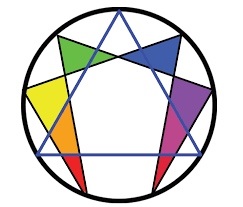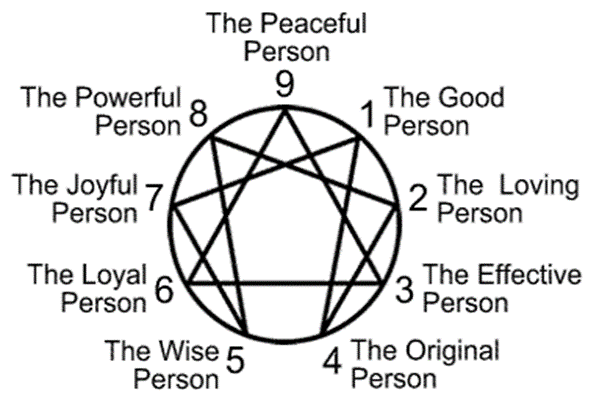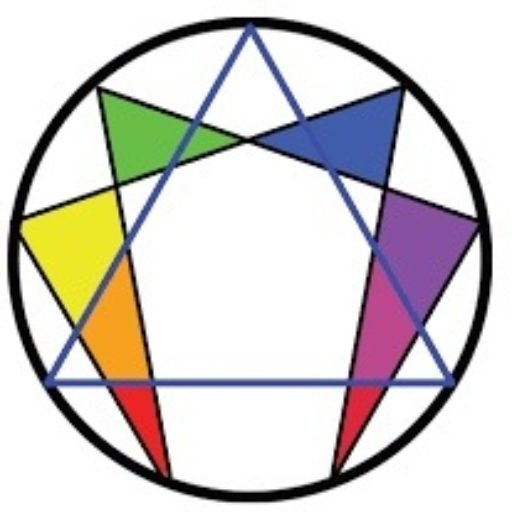What is This Odd-shaped Thing Called the Enneagram?

In 2006 a friend gave me a set of CD’s of a talk given on the Enneagram by well-known spiritual teacher and author, Richard Rohr. I was stunned by the accuracy at which this man explained my personality—both my gifts and pitfalls. It was as if he knew me better than I knew myself. Having a rather conservative background, it was a good thing that I learned about the Enneagram through an audio recording. Otherwise, I most likely would have been scared off by the oddly shaped geometric figure that could have easily passed for something that my Christian roots taught me to avoid like the plague. Amazingly this system points to the roadblocks and the gifts to living an authentic spiritual life while at the same time it expounds on modern psychological insights. This tool has provided me with a deeper self-awareness,
self-compassion and compassion for others, and I am convinced it will do the same for anyone who approaches it with an open mind.
In a nutshell, this system basically states that there are nine basic personality types. The word Enneagram is Greek for “nine points”, with Ennea meaning nine and gram meaning points. The nine personality types are strategically placed around the circumference of a circle to signify their relationship to each other. One type is no better or worse than another so it helps to refer to the type by a number ie. Type 1, Type 2, Type 3,….and type 9. Unlike many personality typing systems, the Enneagram describes the healthy (resourceful) side and unhealthy (less resourceful) side of each personality type. Jerome Wagner, Enneagram teacher author aptly gives the following brief descriptions of each of the nine Enneagram types.

Style ONE: The Good Person
On the Resourceful side, ONEs approach life idealistically. They are high-minded, conscientious, reliable, and hard working. With their high standards and vision and passion for excellence, they want to make the world a better place.
On the Less-Resourceful side, ONEs are perfectionists who notice what is wrong and can become preoccupied with getting everything right. They may become overly responsible, serious, tense, and moralistic.
Style TWO: The Loving Person
On the Resourceful side, TWOs approach life with generosity and nurturance. They care for others and are attuned to others’ needs and feelings. They are supportive, nurturing, encouraging, warm, gentle, and friendly. They want to make the world a more loving place.
On the Less-Resourceful side, TWOs may exaggerate their helpfulness in order to receive attention and approval in return. They may become compulsive rescuers and be disappointed and angry when they are not appreciated.
Style THREE: The Effective Person
On the Resourceful side, THREEs take a practical approach to life. They are competent, productive, efficient and organized. They are enthusiastic motivators and promoters . They want to make the world a more efficient place.
On the Less-Resourceful side, THREES may become preoccupied with their image and focus too much on what others expect. They want to be admired for their accomplishments and performance.
Style FOUR: The Original Person
On the Resourceful side, TWOs approach life with generosity and nurturance. They care for others and are attuned to others’ needs and feelings. They are supportive, nurturing, encouraging, warm, gentle, and friendly. They want to make the world a more loving place.
On the Less-Resourceful side, TWOs may exaggerate their helpfulness in order to receive attention and approval in return. They may become compulsive rescuers and be disappointed and angry when they are not appreciated.
Style THREE: The Effective Person
On the Resourceful side, THREEs take a practical approach to life. They are competent,
productive, efficient and organized. They are enthusiastic motivators and promoters . They
want to make the world a more efficient place.
On the Less-Resourceful side, THREES may become preoccupied with their image and focus too much on what others expect. They want to be admired for their accomplishments and performance.
Style FOUR: The Original Person
On the Resourceful side, TWOs approach life with generosity and nurturance. They care for
others and are attuned to others’ needs and feelings. They are supportive, nurturing, encouraging, warm, gentle, and friendly. They want to make the world a more loving place.
On the Less-Resourceful side, TWOs may exaggerate their helpfulness in order to receive
attention and approval in return. They may become compulsive rescuers and be disappointed
and angry when they are not appreciated.
Style THREE: The Effective Person
On the Resourceful side, THREEs take a practical approach to life. They are competent,
productive, efficient and organized. They are enthusiastic motivators and promoters . They
want to make the world a more efficient place.
On the Less-Resourceful side, THREES may become preoccupied with their image and focus too much on what others expect. They want to be admired for their accomplishments and performance.
Style FOUR: The Original Person
On the Resourceful side, FOURs take a creative approach to life. They value creativity, authenticity, and individuality. They have an appreciation for quality and are deeply sensitive, poetic, and nostalgic. They want to make the world a more beautiful and meaningful place.
On the Less-Resourceful side, FOURs may become overly preoccupied with being special. They may be overly sensitive to being abandoned, left out, or misunderstood, and because of this, they are prone to experience melancholy and envy.
Style FIVE: The Wise Person
On the Resourceful side, FIVEs approach life thoughtfully and objectively. They value truth and have a natural ability to both analyze the essence of things and synthesize the big picture. They want to understand the world and make it a more enlightened place.
On the Less-Resourceful side, FIVEs may become overly intellectual and out of touch with their feelings. They may become overly withdrawn and self-sufficient in order to protect themselves from the perceived withholding or intrusions of others.
Style SIX: The Loyal Person
On the Resourceful side, SIXES take a law-abiding, dutiful approach to life. They are honorable, faithful, responsible, dedicated, and courageous in protecting their family and community. They want to make the world a safer and more predictable place.
On the Less-Resourceful side, SIXES may become overly preoccupied with danger and threats to their security or the security of those to whom they are committed. This may cause them to be fearful and full of doubt or drive them to be counter-fearful, overly confrontational, and aggressive.
Style SEVEN: The Joyful Person
On the Resourceful side, SEVENs approach life with joyous enthusiasm. They are lively, cheerful, and gregarious, and have a natural ability to find the good in everything. They want to make the world a more varied and enjoyable place.
On the Less-Resourceful side, SEVENs may develop an exaggerated need to have fun, to avoid pain, and to keep their options open. While they seek excitement and pleasure, they may avoid the hard work and suffering that often goes along with actually completing the projects they have begun.
Style EIGHT: The Powerful Person
On the Resourceful side, EIGHTs approach life with magnanimity, strength, and fairness. They have a natural ability to get, use, and keep power. They are direct, energetic, confident, and assured. They stand up for the underdog and want to eliminate injustice in the world.
On the Less-Resourceful side, EIGHTs can become overly controlling, aggressive, and vengeful.
They may seek to dominate others and have difficulty being compassionate.
Style NINE: The Peaceful Person
On the Resourceful side, NINEs approach life with acceptance. They are diplomatic and can allow people and events to unfold in their own way and at their own pace. Calm and inclusive, they want to make the world a more harmonious place.
On the Less-Resourceful side, NINEs may become overly passive, lose their own point of view, and avoid taking a stand on anything. They may put off important activities and get lost in unimportant distractions.
These nine personality types are based on basic fears and the strategies we employ to manage
or compensate for the fear. These fears are often out of our awareness and may take some
self-observation and self-awareness to realize and address these basic fears. The basic fear of
each type is as follows:
Type 1 – Fear of being bad, corrupt, evil, or defective.
Type 2 – Fear of being unworthy or unloved.
Type 3 – Fear of being worthless or without inherent value.
Type 4 – Fear of being without identity or personal significance.
Type 5 – Fear of being useless, incapable, or incompetent.
Type 6 – Fear of being without support or guidance.
Type 7 – Fear of being deprived or trapped in pain.
Type 8 – Fear of being harmed or controlled by others.
Type 9 – Fear of loss of connection, of fragmentation.
An acronym for FEAR is False Evidence Appearing Real. This acronym is especially appropriate as your basic fear is nothing more than the childhood monster in your closet that has followed you into your adulthood. Your spiritual and psychological growth begins when you acknowledge and face the basic fear of your type.
Determining your number is the first step on your journey to a richer and healthier relationship with yourself and others. There are many test that you can take to help you discover your Enneagram type, however many test are only 65% to 75% accurate and dependent on one’s ability to see and acknowledge both positive and negative aspects of their personality. There are also many workshops, good books and videos on the market through which you can discover your type.
As part of my coaching and counseling practice I can help you determine your number through a battery of test, one-on-one instructions, and one-on-one interview process. Contact me for a free consultation if you are interested in a personality typing consultation or if you are interested in using the Enneagram as a path of growth or self-discovery.


